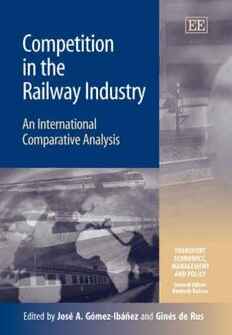
Competition in the Railway Industry: An International Comparative Analysis (Transport Economics, Management, and Policy) PDF
217 Pages·2006·1.028 MB·English
Most books are stored in the elastic cloud where traffic is expensive. For this reason, we have a limit on daily download.
Preview Competition in the Railway Industry: An International Comparative Analysis (Transport Economics, Management, and Policy)
Description:
Numerous countries have attempted to improve the performance of their railways by introducing more competition, but there is fierce debate and no consensus on how this is best achieved. This book reveals how railways were an obvious target for reform because they were often losing traffic and money, and because the government was typically deeply involved as either owner or regulator. This book summarizes and assesses the evidence from the experiences of rail reform in Europe, Latin America, and the United States. In short, the book reveals that no one approach has proven to be best across a wide variety of circumstances. It highlights how unbundling (separating infrastructure from train operations so that independent train operators could compete over common tracks) although attractive in theory, has so far proved complex to implement and delivered only some of the promised benefits. Privatization and deregulation have had more demonstrated success in the freight systems of North and South America, but are still largely untested in the more complex railway networks of Europe. The evidence is arguably slightly stronger for privatization and deregulation than for unbundling, but the jury is still out. "Competition in the Railway Industry" is invaluable in that it compares the strategies and experiences of different countries in introducing competition in railways, rather than simply focusing on one country and its approach. As such, it will appeal greatly to those in industry and government interested in railway policy and performance, and privatization and deregulation of utilities more generally. It will also appeal to academics and researchers of public sector, transport and industrial organization.
See more
The list of books you might like
Most books are stored in the elastic cloud where traffic is expensive. For this reason, we have a limit on daily download.
